Society of St. Joseph of the Sacred Heart
The Society of St. Joseph of the Sacred Heart (SSJ; Latin: Societas Sodalium Sancti Joseph a Sacra Corde) is a society of apostolic life of Catholic priests and brothers headquartered in Baltimore. The members are called Josephites and work specifically among African-Americans.
 | |
| Abbreviation | S.S.J. |
|---|---|
| Formation | May 30, 1893 |
| Founder | John R. Slattery John A. Deruyter Dominic Manley Lambert Welbers Charles Uncles |
| Founded at | Baltimore, Maryland, USA |
| Type | Society of Apostolic Life of Pontifical Right (for Men) |
| Headquarters | PO Box 65010 Baltimore, MD 21209 |
Superior General | Bishop John Ricard |
Patron Saint | St Joseph |
| Website | www |
| Part of a series on |
| Black Catholicism |
|---|
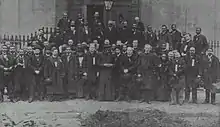 |
| Overview |
|
|
They were formed in 1893 by a group of Mill Hill priests working with newly-freed people emancipated during the American Civil War.[1] This group included Fr John R. Slattery, who led the group and would become the first Josephite Superior General, and one of the nation's first Black priests, Charles Uncles. With permission from the Mill Hill leaders as well as Archbishop of Baltimore Cardinal Gibbons, the group established a mission society independent from Mill Hill, based in America, and dedicated totally to the African-American cause.
History
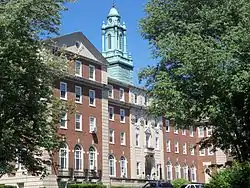
Background (1865-1869)
1865 ushered in the period of Southern Reconstruction, during which time, the Thirteenth Amendment to the United States Constitution, outlawing slavery, was passed.[2] Ten former Confederate states were divided into five military districts. As a condition of readmission to the Union, the former Confederate states were required to ratify the Fourteenth Amendment to the Constitution, which granted citizenship to all people born in the U.S. regardless of race.
It was against this backdrop that the U.S. bishops met for their tenth provincial council in Baltimore, Maryland in 1869. The fifth decree of this council exhorted the Council Fathers to provide missions and schools for all black Americans in their dioceses, as education was seen as a critical need by the community.
Subsequently, the Council Fathers wrote a letter requesting clergy for that purpose to Father Herbert Vaughan, superior general of the Saint Joseph's Society for Foreign Missions in Mill Hill, London. He had founded the society in 1866, and in 1869 opened St Joseph's Foreign Missionary College in that area of London. Later Vaughan was installed as Cardinal Archbishop of Westminster.
Beginnings in America (1870-1893)
Vaughan brought a group of priests to Baltimore in 1871 to form a mission society devoted to freedmen. In 1893, Fr John R. Slattery (a leader within the North American branch of the Mill Hill Fathers) petitioned that they reorganize to create a U.S.-based institution, St. Joseph's Society of the Sacred Heart, aka the "Josephites". The commitment to the African-American apostolate by the new Society was the same as before: to teach the faith of the Catholic Church and to promote the Church’s teachings on social justice.
Bishops around the country had varying constituencies of Black Catholics during this period, and often too few priests, parishes, and programs to serve them. While this didn't necessarily concern individual bishops, the larger bishops' conference for the country (as seen in the Baltimore council) did take up the cause, establishing a system of missionary work to the Black apostolate that was most often filled by groups like the Josephites. As the need arose in a given diocese for Black-focused ministry, they would be called in to pastor parishes, staff schools, and establish missionary posts to gain converts.
Initial Struggles (1893-1933)
Among the small founding group of Josephite priests in 1893 was Fr. Charles R. Uncles, the first African-American priest ordained in the United States (and the first trained in the United States, with his initial studies at a seminary in Quebec).
Fr Uncles would go on to face unremitting opposition both within and outside the order, as ordaining a Black priest and placing one were two entirely different matters. Racist laypeople, priests, and bishops alike soured the new venture, ensuring that Black priests were not welcome in local parishes and communities—stifling Slattery's dreams of a booming Black priestly class. Instead, Black priests like Uncles were relegated to preaching tours in the Deep South, subservient parochial roles, and teaching posts at the Josephite seminary in DC. Meanwhile, the White Josephite priests pressed on, expanding their work across the country.
Slattery would eventually lose hope in the mission, in Catholicism, and in Christianity overall—leaving his post, the priesthood and eventually the Church. He would marry and become a successful lawyer. For his part, Fr Uncles died an outcast within the order, frustrated by circumstances to the point that he no longer considered himself a Josephite at all.
Growth and Racism (1933-1950)
After the initial experiences with Uncles and a scant few others, subsequent Josephite Superior Generals were hesitant to accept Black candidates to the order at all; they accepted a mulatto here and there, but largely stayed away from the question of Black priests even as they continued to work with Blacks.
This reticence (and vocational dearth) was noticed by Black Catholics themselves, most notably Thomas Wyatt Turner and his Federated Colored Catholics organization. This pressure would not have much effect for many years, but the issue remained on the table as the Josephites continued to grow in both membership and parochial administration.
Louis Pastorelli, the Josephite's longest-serving Superior General, throughout the Interwar Period continued the society's policy of restricting Black candidates, but cautiously supported other orders' Black priesthood efforts—specifically the Divine Word order's plans for a Black seminary in Mississippi, which quickly produced four new, well-received Black priests.
As more dioceses and orders began to accept Black candidates into their priestly formation programs, the Josephites slowly became more open to receiving Black candidates without restriction. During the 1940s, Josephite Superior General Edward V Casserly instituted official policies allowing more freely for Black applicants. During the same period, the order also added 20 parishes and 20 schools—including the all-Black (and all-male) St Augustine High in New Orleans, formerly a diocesan school.
Civil Rights and Black Power (1950-1971)
As the door flew open to Black priests in the lead-up to the Civil Rights Movement, the Josephite order faced the possibility of changing color, causing consternation among not a few members. One higher-up from the old guard went so far as to institute an explicitly racist policy to prevent Black applications from being assessed at all; Casserly quickly called a meeting of the leadership and quashed the overreach. The Josephites had turned a corner. Even so, Casserly's heavy-handed management style made for an abrupt end in 1948 to his tenure as superior general. His successor, Thomas P. McNamara (and McNamara's right-hand man, future superior general George F. O'Dea), would continue the expansion of Josephite activity and Black vocations.
After a few decades of positive signs and progress (including the notable saga of oft-arrested Josephite activist Philip Berrigan), the bloody end to the Civil Rights Movement proper presented a new challenge: Black radicalism. The assassination of Martin Luther King Jr brought issues of racism to a head and fostered a newfound commitment to social justice and Black Power among many Black clergy and religious. This began in earnest with the convening of the inaugural National Black Catholic Clergy Caucus (NBCCC), held in Detroit in April 1968, shortly after King's assassination and the resultant riots. It was the first-ever meeting of the nation's Black Catholic clergy and produced a statement that in its opening line called the Catholic Church in America "primarily a White, racist institution."[3]
This helped produce calls for more authentic Black freedom and expression, as well as Black oversight of Black parishes and schools, causing tension across the Church—including at St Joseph's Seminary (the Josephite house). Eventually a good number of seminarians would leave or be asked to leave the order altogether, causing the seminary to close for studies in 1971. Josephite seminarians have studied at the nearby Catholic University of America and/or Howard University ever since.
A New Era (1971-present)
During the 1980s, the Rt Rev Fr William Norvel served as consultor general for the Josephites and as president of the NBCCC. He is credited with starting the Catholic gospel choir movement in Washington, D.C. and Los Angeles, implementing in a liturgical way some of the calls for Black expression that came out of the Detroit meeting.
In June 2011, some 130 years after their founding, the Josephites elected Norvel as their first Black Superior General.[4]
Both of the following Superior Generals have also been Black, including the sitting, Bishop John Ricard.
Norvel also established a Josephite house of spiritual formation in Nigeria, where he served for five years and which now produces most of the Josephite's vocations; the current crop of seminarians is almost entirely Nigerian.
St Joseph's Manor, which had been the residence of the Superior General and other administrators, was sold in January 2019. They now reside nearby in a shared residential and office space, which has functioned as the Josephites headquarters since around 2016.
Organization and membership
The society operates 34 parishes across 12 (arch)dioceses, as well as St. Augustine High School in New Orleans, Louisiana, a historically black high school, established by the society with the Archdiocese of New Orleans in 1951.
The headquarters is located in northern Baltimore and their seminarian and retiree residence, St. Joseph Seminary, is in Washington, DC.
In 2012, the society had 40 houses and 88 members, including 76 priests.
In late 2020, Vicar General Fr Thomas Frank reported that the order had 60 members.
The Josephite Harvest (magazine)
The Josephite Harvest is the official magazine of the society, and is the longest-running Catholic missions magazine still in existence in the US today.
It first began in 1888, published under the name The Colored Harvest, before changing its name in 1960 to The Josephite Harvest.
During the 20th century, The Harvest chronicled the Josephites' efforts to build parishes and schools for African-Americans throughout the nation.
Superiors General
| No. | Name | Took office | Left office | Birthplace | |
|---|---|---|---|---|---|
| 1 | John R. Slattery | 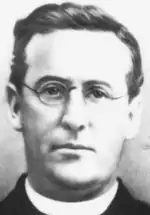 |
1893 | 1904 | New York City |
| 2 | Thomas B. Donovan | 1904 | 1908 | Kentucky | |
| 3 | Justin McCarthy | 1908 | 1918 | Ireland | |
| 4 | Louis B. Pastorelli | 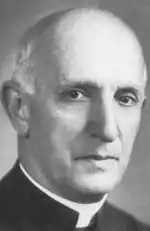 |
1918 | July 1942 | Boston, Massachusetts |
| 5 | Edward V. Casserly | 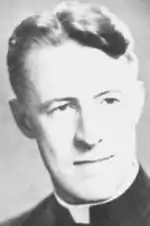 |
1942 | 1948 | Ireland |
| 6 | Thomas P. McNamara | 1948 | 1960 | Philadelphia, Pennsylvania | |
| 7 | George F. O'Dea | July 1960 | October 1970 | Brooklyn, New York City | |
| 8 | Matthew J. O'Rourke | 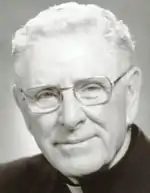 |
July 1971 | Bronx, New York City | |
| 9 | Eugene Patrick McManus | 1988 | 1995 | ||
| 10 | Robert Michael Kearns | 1995 | June 17, 2003 | Boston, Massachusetts | |
| 11 | Edward J. Chiffriller | 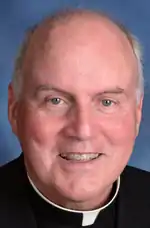 |
June 17, 2003 | June 15, 2011 | |
| 12 | William L. Norvel | 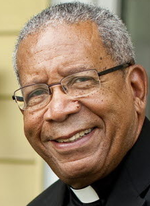 |
June 15, 2011 | June 19, 2015 | Pascagoula, Mississippi |
| 13 | Michael Thompson |  |
June 19, 2015 | August 1, 2019 | Port Arthur, Texas |
| 14 | Bishop John Ricard | August 1, 2019 | present | Baton Rouge, Louisiana |
Prelates from their ranks
- Alive
- Bishop John Huston Ricard (75 in 2015), Bishop emeritus of Pensacola–Tallahassee (USA)
- Deceased (by year of death)
- 1993: Bishop Carl Anthony Fisher, Auxiliary Bishop of Los Angeles (USA)
- 2000: Archbishop Eugene Antonio Marino, Metropolitan Archbishop emeritus of Atlanta (USA)
See also
References
- "OUR HISTORY | Society of St. Joseph of the Sacred Heart". Retrieved 2020-09-24.
- 13th Amendment to the U.S. Constitution: Abolition of Slavery (1865)
- Tinner-Williams, Nate (2020-05-30). "Statement of the Black Catholic Clergy Caucus, 1968". Where Peter Is. Retrieved 2020-09-24.
- "Catholic News Service". Archived from the original on 2012-07-22. Retrieved 2011-06-24.
